
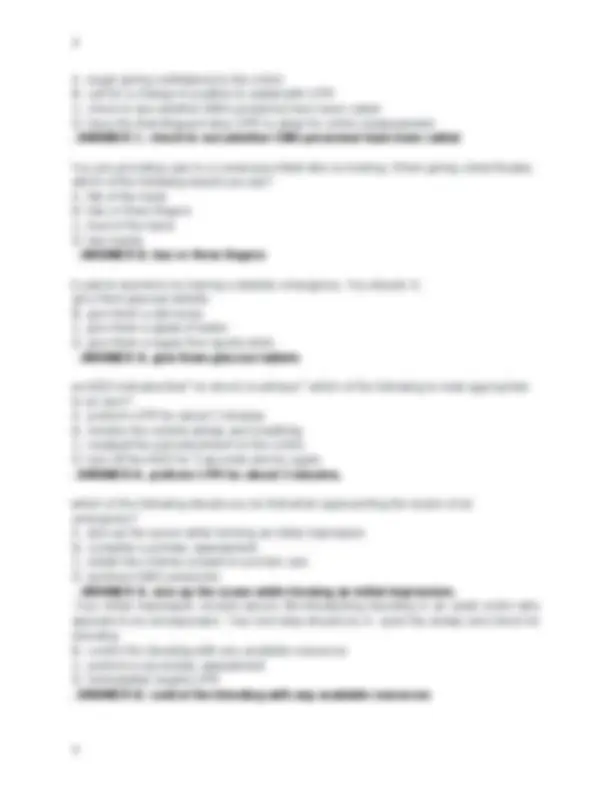
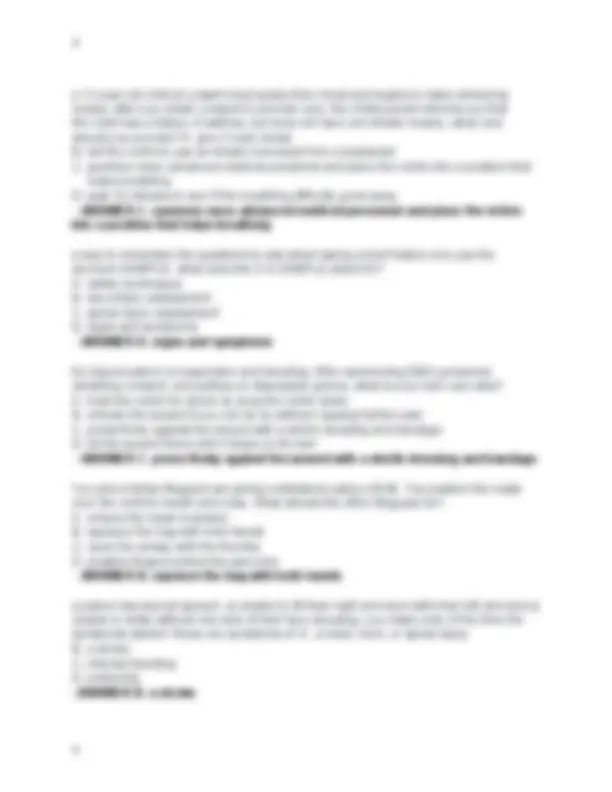
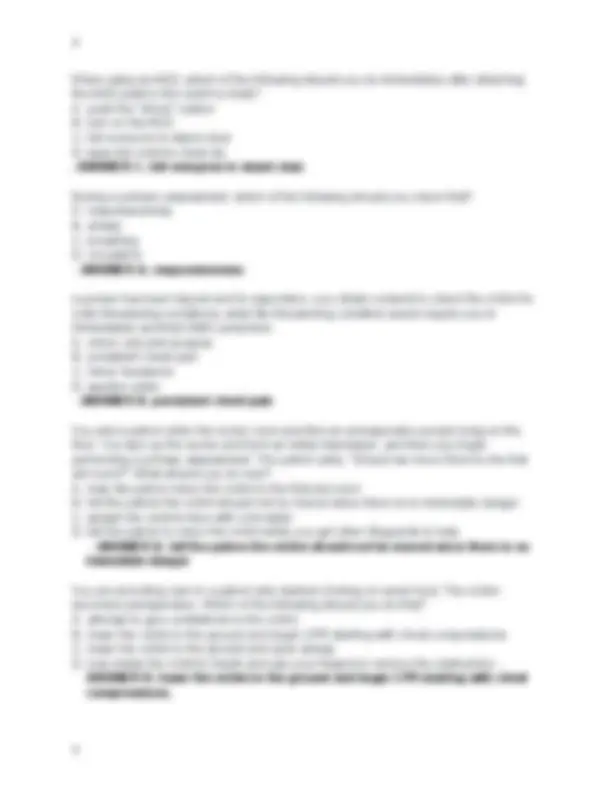
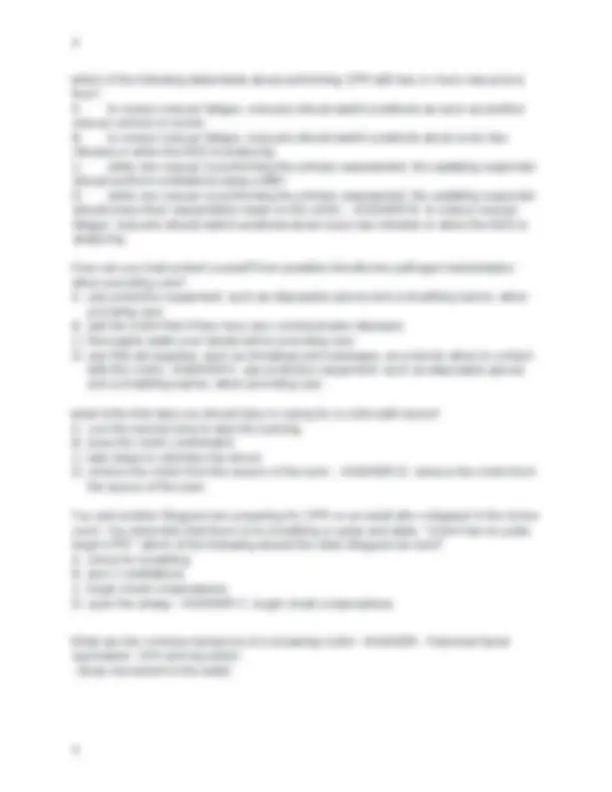
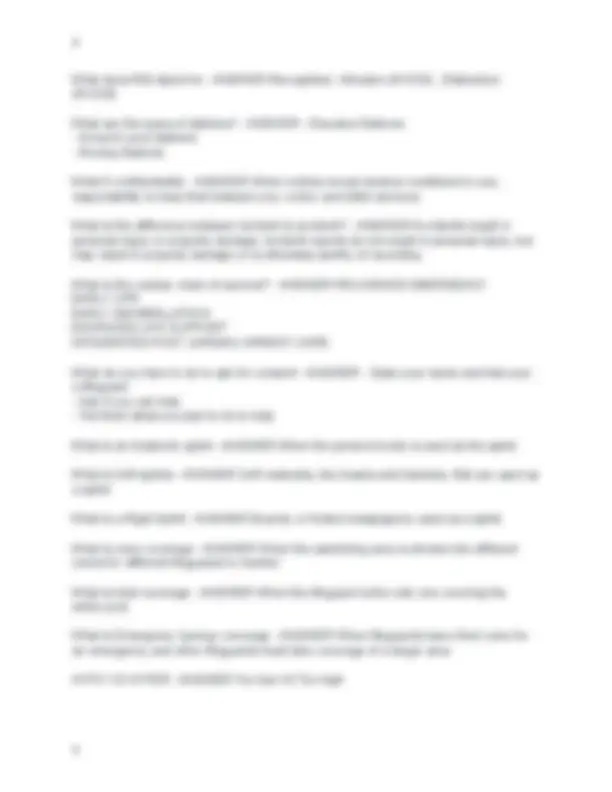
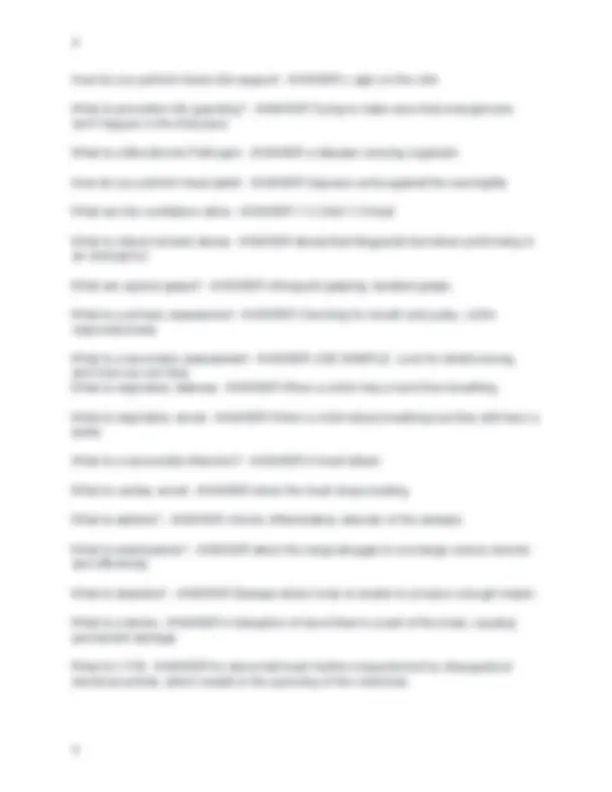
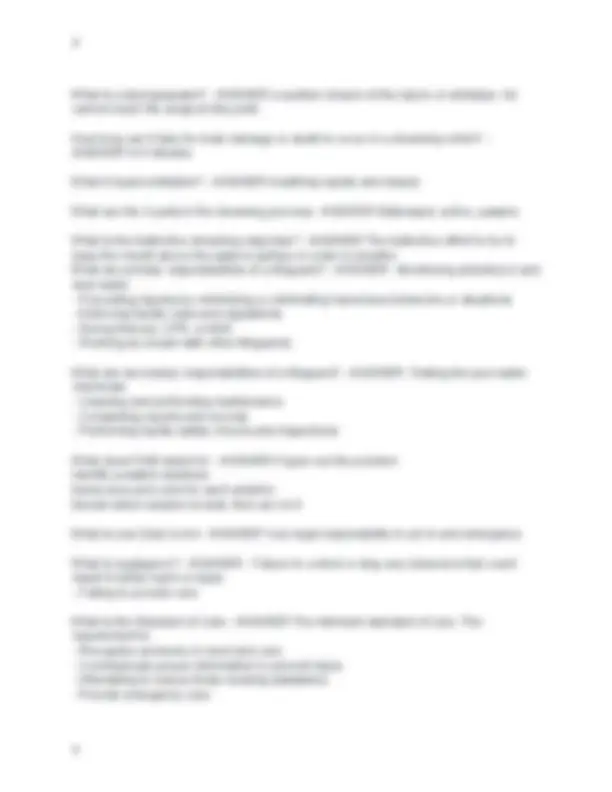
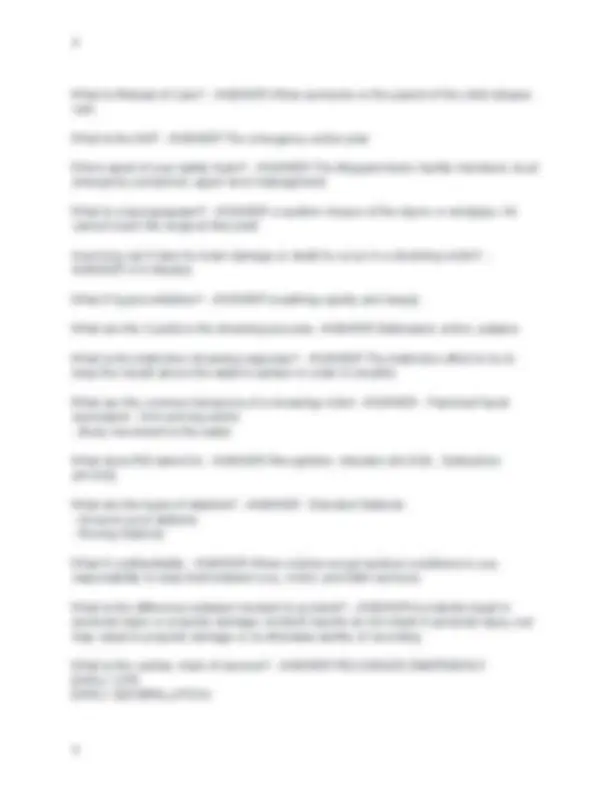
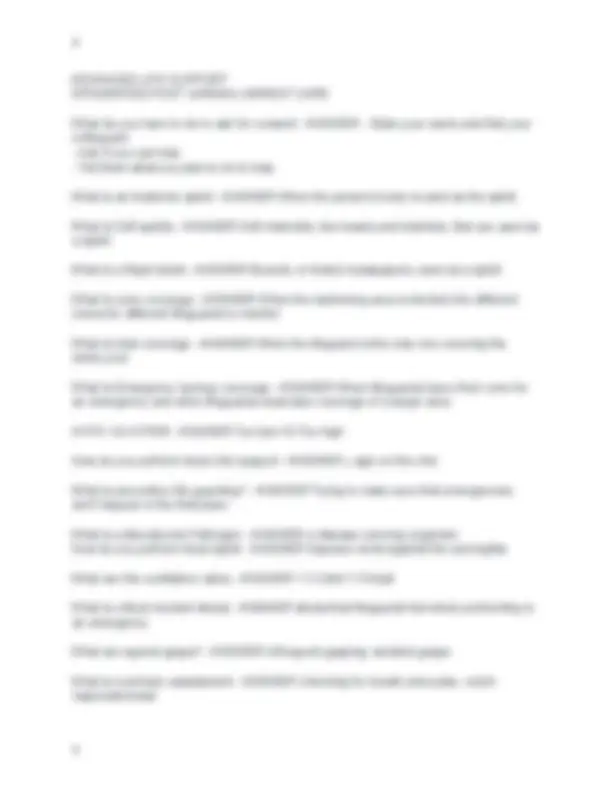






Study with the several resources on Docsity

Earn points by helping other students or get them with a premium plan


Prepare for your exams
Study with the several resources on Docsity

Earn points to download
Earn points by helping other students or get them with a premium plan
Community
Ask the community for help and clear up your study doubts
Discover the best universities in your country according to Docsity users
Free resources
Download our free guides on studying techniques, anxiety management strategies, and thesis advice from Docsity tutors
When giving chest compressions to an adult, how would you position your hands? A. side-by-side in the middle of the victim's chest B. encircling the chest with the thumbs centered at the nipple line C. heel of one hand on the center of the chest with the other hand on top D. three fingers of one hand on the chest with the palm of the other on top - ANSWER C. heel of one hand on the center of the chest with the other hand on top you are walking on the pool deck when the swim team coach suddenly collapses in front of you. during your primary assessment, you find the victim does not have a pulse. you should: A. give ventilations at a rate of 1 about every 5-6 seconds B. immediately begin CPR using cycles of 30 compressions followed by 2 ventilations. C. give 2 ventilations before beginning CPR D. immediately begin CPR using cycles of 15 compressions followed by 2 ventilations - ANSWER B. immediately begin CPR using cycles of 30 compressions followed by 2 ventilatio
Typology: Exams
1 / 21

This page cannot be seen from the preview
Don't miss anything!














When giving chest compressions to an adult, how would you position your hands? A. side-by-side in the middle of the victim's chest B. encircling the chest with the thumbs centered at the nipple line C. heel of one hand on the center of the chest with the other hand on top D. three fingers of one hand on the chest with the palm of the other on top
- ANSWER C. heel of one hand on the center of the chest with the other hand on top you are walking on the pool deck when the swim team coach suddenly collapses in front of you. during your primary assessment, you find the victim does not have a pulse. you should: A. give ventilations at a rate of 1 about every 5-6 seconds B. immediately begin CPR using cycles of 30 compressions followed by 2 ventilations. C. give 2 ventilations before beginning CPR D. immediately begin CPR using cycles of 15 compressions followed by 2 ventilations - ANSWER B. immediately begin CPR using cycles of 30 compressions followed by 2 ventilations. which of the following would you identify as the universal sign that a conscious person is chocking? A. coughing B. ability to speak or cry C. yelling out "i'm chocking" D. clutching the throat - ANSWER D. clutching the throat As you are giving ventilations with a resuscitation mask, the victim vomits. Which of the following would you do first? A. leave the victim in a face-up position and clear the airway of the commit immediately B. reposition the victim's head to reopen the airway C. use greater force when ventilating to bypass the vomit
D. turn the victim onto their side and clear the airway of the vomit immediately. - ANSWER D. turn the victim onto their side and clear the airway of the vomit immediately. Based on which of the following signs and symptoms would you determine that a victim is experiencing respiratory distress? A. complaints of feeling " really thirsty." B. sneezing with watery eyes C. gasping for breath D. yellowish skin
- ANSWER C. gasping for breath which of the following statements about bag-valve-mask resuscitators (BMVs) is most accurate? A. BMVs are readily available at all emergency scenes. B. monitoring the victim for full exhalation is not required C. ventilations are more effective when two rescuers operate the BMV D. when used by a single rescuer, BMVs allow easy coordination with chest compressions - ANSWER C. ventilations are more effective when two rescuers operate the BMV all of the following are components of scene size-up EXCEPT: A. gathering an initial impression of the situation B. calling for additional resources as needed C. looking for situations that are hazardous D. checking for responsiveness - ANSWER D. checking for responsiveness As the only lifeguard performing CPR on a 7-year-old, you would perform cycles of: A. 15 chest compressions and 2 ventilations B. 20 chest compressions and 1 ventilation C. 25 chest compressions and 1 ventilation D. 30 chest compressions and 2 ventilations. - ANSWER D. 30 chest compressions and 2 ventilations. if a victim is having a seizure in the water: A. support the victim with their head above water until the seizure ends B.immediately get them out of the water C. immediately move the victim to shallow water until the seizure ends, if the victim is in deep water D. secure the victim onto a backboard - ANSWER A. support the victim with their head above water until the seizure ends You are performing CPR on a victim, and an assisting responder arrives. Which of the following is most appropriate for the assisting responder to do first?
a 12-year-old child at a swim meet grabs their chest and begins to make wheezing noises. after you obtain consent to provide care, the childs parent informs you that the child has a history of asthma, but does not have am inhaler nearby. what care should you provide? A. give 5 back blows B. tell the victim to use an inhaler borrowed from a bystander C. summon more advanced medical personnel and place the victim into a position that helps breathing D. wait 20 minutes to see if the breathing difficulty goes away
- ANSWER C. summon more advanced medical personnel and place the victim into a position that helps breathing a way to remember the questions to ask when taking a brief history is to use the acronym SAMPLE. what does the S in SAMPLE stand for? A. safety techniques B. secondary assessment C. spinal injury assessment D. signs and symptoms - ANSWER D. signs and symptoms An injured patron is responsive and bleeding. After summoning EMS personnel, obtaining consent, and putting on disposable gloves, what is your next care step? A. treat the victim for shock by lying the victim down B. elevate the wound if you can do so without causing further pain. C. press firmly against the wound with a sterile dressing and bandage D. let the wound bleed until it stops on its own - ANSWER C. press firmly against the wound with a sterile dressing and bandage You and a fellow lifeguard are giving ventilations using a BVM. You position the mask over the victim's mouth and nose. What should the other lifeguard do? A. ensure the mask is sealed B. squeeze the bag with both hands C. open the airway with the thumbs D. position fingers behind the jaw bone - ANSWER B. squeeze the bag with both hands a patron has slurred speech, is unable to lift their right arm level with their left arm and is unable to smile without one side of their face drooping. you make note of the time the symptoms started. these are symptoms of: A. a head, neck, or spinal injury. B. a stroke C. internal bleeding D. poisoning - ANSWER B. a stroke
When using an AED, which of the following should you do immediately after attaching the AED pads to the victim's chest? A. push the "shock" button B. turn on the AED C. tell everyone to stand clear D. wipe the victim's chest dry
- ANSWER C. tell everyone to stand clear During a primary assessment, which of the following should you check first? A. responsiveness B. airway C. breathing D. circulation - ANSWER A. responsiveness a person has been injured and is responsive. you obtain consent to check the victim for a life-threatening conditions. what life-threatening condition would require you to immediately summon EMS personnel. A. minor cuts and scrapes B. persistent chest pain C. minor headache D. swollen ankle - ANSWER B. persistent chest pain You and a patron enter the locker room and find an unresponsive person lying on the floor. You size up the scene and form an initial impression, and then you begin performing a primary assessment. The patron asks, "Should we move them to the first aid room?" What should you do next? A. help the patron move the victim to the first aid room B. tell the patron the victim should not be moved since there is no immediate danger C. splash the victim's face with cold water D. tell the patron to move the victim while you get other lifeguards to help. - ANSWER B. tell the patron the victim should not be moved since there is no immediate danger You are providing care to a patron who started choking on some food. The victim becomes unresponsive. Which of the following should you do first? A. attempt to give ventilations to the victim B. lower the victim to the ground and begin CPR starting with chest compressions. C. lower the victim to the ground and open airway D. look inside the victim's mouth and use your fingers to remove the obstruction. - ANSWER B. lower the victim to the ground and begin CPR starting with chest compressions.
chest does not rise. Which of the following should you do next? A. change the position of the mask and then look for chest movement. B. blow into the mask more forcefully and then look for the chest to rise C. re-tilt the victim's head, then attempt another ventilation D. give 5 back blows and then check the victim's mouth
- ANSWER C. re-tilt the victim's head then attempt another ventilation You are giving ventilations to a 5-year-old child using a resuscitation mask. You should give 1 ventilation about every: A. 1 second B. 2 seconds C. 3 seconds D. 4 seconds - ANSWER C. 3 seconds You arrive on a scene where someone seems to be hurt. During the primary assessment, you should check for all of the following EXCEPT: A. swelling B. bleeding C. breathing D. consciousness - ANSWER A. swelling To ensure high-quality CPR and high-quality chest compressions, you should: A. keep your shoulders directly over your hands and bend your elbows B. expose the victim's chest to ensure proper hand placement and full chest recoil. C. compress the victim's chest to a shallow depth. D. place the victim on a soft flat surface. - ANSWER B. expose the victim's chest to ensure proper hand placement and full chest recoil. a patron has cut their leg on the edge of the bleachers and is bleeding heavily. you think the patron is in shock because they: A. become restless and irritable. B. have a red rash C. have a dry skin. D. are calm and quiet. - ANSWER A. become restless and irritable. While preparing to use an automated external defibrillator (AED) on a victim, you notice a medication patch on the victim's chest. Which action is most appropriate? A. removing the patch with a gloved hand B. applying one of the pads directly over the patch C. placing one pad on the victim's chest and the other on their back D. wiping the victim's chest dry, avoiding the patch - ANSWER A. removing the patch with a gloved hand
which of the following statements about performing CPR with two or more rescuers is true? A. to reduce rescuer fatigue, rescuers should switch positions as soon as another rescuer arrives on scene B. to reduce rescuer fatigue, rescuers should switch positions about every two minutes or when the AED is analyzing C. while one rescuer is performing the primary assessment, the assisting responder should perform ventilations using a BMV D. while one rescuer is performing the primary assessment, the assisting responder should place-their resuscitation mask on the victim. - ANSWER B. to reduce rescuer fatigue, rescuers should switch positions about every two minutes or when the AED is analyzing How can you best protect yourself from possible bloodborne pathogen transmission when providing care? A. use protective equipment, such as disposable gloves and a breathing barrier, when providing care B. ask the victim first if they have any communicable diseases C. thoroughly wash your hands before providing care D. use first aid supplies, such as dressings and bandages, as a barrier when in contact with the victim - ANSWER A. use protective equipment, such as disposable gloves and a breathing barrier, when providing care what is the first step you should take in caring for a victim with burns? A. cool the burned area to stop the burning B. keep the victim comfortable C. take steps to minimize the shock D. remove the victim from the source of the burn. - ANSWER D. remove the victim from the source of the burn. You and another lifeguard are preparing for CPR on an adult who collapsed in the locker room. You determine that there is no breathing or pulse and state, "victim has no pulse. begin CPR." which of the following should the other lifeguard do next? A. check for breathing B. give 2 ventilations C. begin chest compressions D. open the airway - ANSWER C. begin chest compressions What are the common behaviors of a drowning victim - ANSWER - Panicked facial expression - Arm and leg action
How do you perform head chin support - ANSWER L sign on the chin What is preventive life guarding? - ANSWER Trying to make sure that emergencies don't happen in the first place What is a Bloodborne Pathogen - ANSWER a disease carrying organism How do you perform head splint - ANSWER Squeeze arms against the ears tightly What are the ventilation ratios - ANSWER 1:3 Child 1:5 Adult What is critical incident stress - ANSWER stress that lifeguards feel when performing in an emergency What are agonal gasps? - ANSWER infrequent gasping; isolated gasps What is a primary assessment - ANSWER Checking for breath and pulse, victim responsiveness What is a secondary assessment - ANSWER USE SAMPLE. Look for what's wrong, and how you can help What is respiratory distress - ANSWER When a victim has a hard time breathing What is respiratory arrest - ANSWER When a victim stops breathing but they still have a pulse What is a myocardial infarction? - ANSWER A heart attack What is cardiac arrest - ANSWER when the heart stops beating What is asthma? - ANSWER chronic inflammatory disorder of the airways What is emphysema? - ANSWER when the lungs struggle to exchange carbon dioxide and effectively What is diabetes? - ANSWER Disease where body is unable to produce enough insulin. What is a stroke - ANSWER A disruption of blood flow to a part of the brain, causing permanent damage What is V FIB - ANSWER An abnormal heart rhythm characterized by disorganized electrical activity, which results in the quivering of the ventricles.
What is V tach - ANSWER An abnormal heart rhythm characterized by rapid contractions of the ventricles. What is a seizure? - ANSWER sudden surge of electrical activity in the brain What is a stoma? - ANSWER An opening in the front of the neck through which a person whose larynx has been removed breathes. (THOSE CIGARETTE COMMERCIALS) What is hypoxia? - ANSWER lack of oxygen What is cyanosis? - ANSWER blue discoloration of the skin What is epilepsy? - ANSWER Recurrent seizures What is anaphylaxis? - ANSWER Life threatening allergic reaction WHAT DOES SAMPLE STAND FOR - ANSWER Signs & Symptoms Allergies Medications Past Medical History Last Oral Intake Events Leading Up To The Incident What does LOC stand for? - ANSWER Level Of Consciousness What is RID stand for - ANSWER Recognition Intrusion Distraction (Things that prevent lifeguards from saving someone) What is HIPPA? - ANSWER Health Insurance Portability and Accountability What is MSDS - ANSWER Material Safety Data Sheet What is OSHA - ANSWER Occupational Safety and Health Administration What does AED stand for? - ANSWER automated external defibrillator What does CPR stand for? - ANSWER cardiopulmonary resuscitation What does RICE stand for - ANSWER rest, ice, compression, elevation
What is a laryngospasm? - ANSWER a sudden closure of the larynx or windpipe. Air cannot reach the lungs at this point How long can it take for brain damage or death to occur in a drowning victim? - ANSWER 4-6 minutes What it hyperventilation? - ANSWER breathing rapidly and deeply What are the 3 parts to the drowning process - ANSWER Distressed, active, passive What is the instinctive drowning response? - ANSWER The instinctive effort to try to keep the mouth above the water's surface in order to breathe What are primary responsibilities of a lifeguard? - ANSWER - Monitoring activities in and near water
What is Refusal of Care? - ANSWER When someone or the parent of the child refuses care What is the EAP - ANSWER The emergency action plan Who's apart of your safety team? - ANSWER The lifeguard team, facility members, local emergency personnel, upper level management What is a laryngospasm? - ANSWER a sudden closure of the larynx or windpipe. Air cannot reach the lungs at this point How long can it take for brain damage or death to occur in a drowning victim? - ANSWER 4-6 minutes What it hyperventilation? - ANSWER breathing rapidly and deeply What are the 3 parts to the drowning process - ANSWER Distressed, active, passive What is the instinctive drowning response? - ANSWER The instinctive effort to try to keep the mouth above the water's surface in order to breathe What are the common behaviors of a drowning victim - ANSWER - Panicked facial expression - Arm and leg action
What is a secondary assessment - ANSWER USE SAMPLE. Look for what's wrong, and how you can help What is respiratory distress - ANSWER When a victim has a hard time breathing What is respiratory arrest - ANSWER When a victim stops breathing but they still have a pulse What is a myocardial infarction? - ANSWER A heart attack What is cardiac arrest - ANSWER when the heart stops beating What is asthma? - ANSWER chronic inflammatory disorder of the airways What is emphysema? - ANSWER when the lungs struggle to exchange carbon dioxide and effectively What is diabetes? - ANSWER Disease where body is unable to produce enough insulin. What is a stroke - ANSWER A disruption of blood flow to a part of the brain, causing permanent damage What is V FIB - ANSWER An abnormal heart rhythm characterized by disorganized electrical activity, which results in the quivering of the ventricles. What is V tach - ANSWER An abnormal heart rhythm characterized by rapid contractions of the ventricles. What is a seizure? - ANSWER sudden surge of electrical activity in the brain What is a stoma? - ANSWER An opening in the front of the neck through which a person whose larynx has been removed breathes. (THOSE CIGARETTE COMMERCIALS) What is hypoxia? - ANSWER lack of oxygen What is cyanosis? - ANSWER blue discoloration of the skin What is epilepsy? - ANSWER Recurrent seizures What is anaphylaxis? - ANSWER Life threatening allergic reaction WHAT DOES SAMPLE STAND FOR - ANSWER Signs & Symptoms
Allergies Medications Past Medical History Last Oral Intake Events Leading Up To The Incident What does LOC stand for? - ANSWER Level Of Consciousness What is RID stand for - ANSWER Recognition Intrusion Distraction (Things that prevent lifeguards from saving someone) What is HIPPA? - ANSWER Health Insurance Portability and Accountability What is MSDS - ANSWER Material Safety Data Sheet What is OSHA - ANSWER Occupational Safety and Health Administration What does AED stand for? - ANSWER automated external defibrillator What does CPR stand for? - ANSWER cardiopulmonary resuscitation What does RICE stand for - ANSWER rest, ice, compression, elevation What does FACE stand for - ANSWER Face Arm Speech Time (Used to figure out if someone has a stroke or not) what information do patrons need to know concerning risky behavior? - ANSWER +why its dangerous +why the rule is in place +what could happen if they continued to break the rule EAP - ANSWER emergency action plan injury prevention - ANSWER +verbal communication +positive attitude +consequences unique risks for old people - ANSWER +heat illness
+blood cleanup kit Primary disease concerns - ANSWER +hepatitis B&C +HIV BSI - ANSWER blood substance isolation PPE - ANSWER personal protective equipment OPIM - ANSWER other potential infectious material EMS - ANSWER emergency medical services primary assessment - ANSWER check for life threatening injuries secondary assessment - ANSWER check for NON life threatening injuries +look for medical id tag +look for bleeding, cuts, bruising, etc. BVM - ANSWER bag valve mask +takes two people purpose of scene size up - ANSWER +your personal safety +tell whats going on +assess to see how many injured there are checking infant's pulse - ANSWER bronchial(arm) checking children/adults pulse - ANSWER carotid(neck) LOC - ANSWER level of consciousness opening airways for ventilation - ANSWER +jaw thrust w/ head extension +jaw thrust w/o head extension +chin lift w/ head tilt conditions where you MUST call EMS - ANSWER +cardiac arrest +seizures +unconscious choking +drowning causes of hypoxia - ANSWER +exhaustion +choking +allergies
+suffocation respiratory distress - ANSWER condition in which breathing becomes difficult respiratory arrest - ANSWER condition in which breathing completely stops five links of cardiac chain of survival (Adult) - ANSWER +recognition +early CPR +early defibrillation(AED) +EMS/advanced life support +hospital care/post cardiac care links of cardiac chain of survival(Pediatric) - ANSWER +prevention of cardiac arrest +early CPR +EMS +effective and advanced life support Reasons to stop CPR - ANSWER +AED +obvious sign of life +EMS takes over +Alone and too exhausted to continue +Situation becomes dangerous for you CPR(Adults) - ANSWER +100 beats per minute +30 pulses every 2 breaths CPR(infants) - ANSWER +obstructed airway cpr is 30; +dislodge object by putting baby on your knee +TWO person is 15: an AED CAN be used - ANSWER +on pregnant women +in the rain +in snow +w/ jewelry on +on someone w/ a pacemaker +on someone w/ dramatic injuries +on someone w/ hypothermia secondary assessment SAMPLE - ANSWER Signs/symptoms Allergies Medications Pertinent past medical history Last oral intake